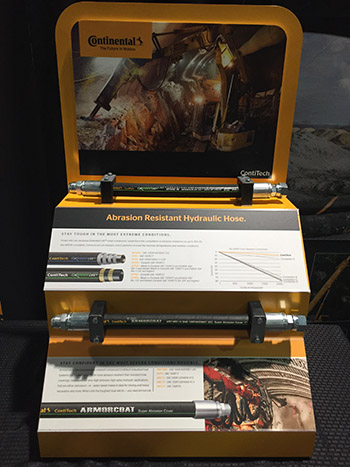 Fairlawn, Ohio-based Continental ContiTech is a manufacturer of industrial and hydraulic hoses. At the IFPE show in Las Vegas this month, I had the chance to catch up with Randy Kish, the company’s Manager, Distributor Marketing for Industrial Hose & Hydraulics.
Fairlawn, Ohio-based Continental ContiTech is a manufacturer of industrial and hydraulic hoses. At the IFPE show in Las Vegas this month, I had the chance to catch up with Randy Kish, the company’s Manager, Distributor Marketing for Industrial Hose & Hydraulics.
Kish noted that while “everybody in hydraulics follows SAE standards” for hose—meaning that the hose either meets or exceeds the standards—ContiTech’s hose goes far beyond that, to half bend radius.
“This hose is good for industries across the board, but specifically where you need good flexibility and a small bend radius. For example, on mobile equipment where there are implements, as well as for tools and construction. On the industrial side, it could be used on an injection molding machine, where you see very high pressure and a lot of flexing. When that ram moves, there is flexing in isolation.”
Kish also repeated the oft-heard warning that engineers should never put one manufacturer’s fitting on another one’s hose.
“It’s just a safety issue. It’s just too critical. Safety is the most important thing,” he said.
One of the benefits that ContiTech touts is its hoses’ abrasion resistance. Kish said the company’s armor coat is the most significant, and is rated at 400 times the abrasion resistance of a standard hydraulic coat.
“It’s got a cover on the outside that you can just drag and drag and drag—and it’s going to last a long time. Realize that abrasion is really the killer for hydraulics,” he said. “In mining, construction, and those types of applications, you’re getting sand, gravel, oil over things. Cover technology is critical to the application.”
Kish explained that they sell a variety of hoses with different amounts of abrasion resistance.
“There are different cover technologies, and different price points. Those obviously mean a different life expectancy. Every application is different. You don’t over-design and try to sell it a Cadillac when you only need a Pinto,” he said.
On the process side of things, ContiTech has put some of that same abrasion technology that’s on the outside of hoses on the inside of hoses—for when gravel or concrete is being transferred.
Overall, Kish stressed that ContiTech is a problem solving company.
“If you have a problem, we have the compounder, the engineers to back it up, to help you understand, and ask questions,” he said.
Filed Under: Hose Assembly Tips